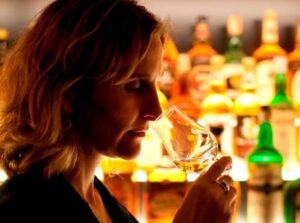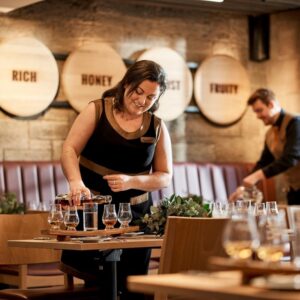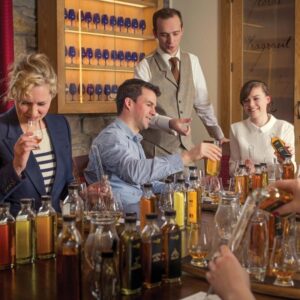Whisky or whiskey?
A handy guide to understanding the difference between whisky and whiskey
The main difference between whisky and whiskey is of course the spelling. This reflects the original Scots and Gaelic derivations of the word ‘Uisce beatha’, meaning Water of Life, with each variation being carried through to modern use. Irish immigration to America in the 18th century means that we also refer to American ‘whiskey’ spelled with an e.
But ‘whisky’ and ‘whiskey’ are just two varieties of a wide family of spirits and alcohol – understanding what makes each one different key to unlocking a spectrum of flavours and experiences…

Scotch Whisky
Scotch Whisky is always spelled without the e. In order to be officially called Scotch whisky:
- The spirit needs to mature in oak for at least three years
- Production and maturation must take place in Scotland.
- Single malt Scotch whisky must be made from 100% malted barley.
Find out more about how Scotch whisky is made here.
Irish Whiskey
Irish whiskey is always spelled with an e – this is a key difference between Irish whiskey and Scotch whisky.
- Irish whiskey uses little or no peat, so there is usually no smokiness in these whiskies.
- Irish whiskey may contain a distillate of malt, a barley distillate and a portion of grain spirit.
- Irish whiskey is distilled three times.
- Like Scotch whisky, Irish whiskey must be matured for a legal minimum of three years.

Other whiskies from around the world
Bourbon
- Bourbon is American whiskey that has been made from a minimum of 51% corn with rye and malted barley. Examples of bourbon include Jim Beam and Wild Turkey whiskey.
- Bourbon is a very small area of Kentucky where bourbons were originally produced, but since 1964 American law has stated bourbon can be made anywhere in the USA.
- In Bourbon whiskey, the residue from the pot still is mixed with the mash to create a ‘sour mash’ whiskey.
- Distillation of bourbon usually takes place in a column still and then a pot still, but sometimes only column stills are used – Woodford Reserve operate a triple distillation in pot stills.
- Bourbon spirit is always matured in fresh oak casks, which are charred to yield more flavour.
Rye Whisky
- Rye whiskey is made in the same way as bourbon, but is made up of 51% rye. Examples of rye whiskey include Wild Turkey Rye and Jim Beam Rye.
- Rye whiskies send to be spicier in character.
- Tennessee whiskey is made in the same way as bourbon, but it is charcoal mellowed before maturation
Japanese Whisky
- Japanese whisky came into being in the 1920s. It was inspired by Scotch whisky – Scottish academic institutions trained the first whisky makers of Japan. This means that the process of making Japanese whisky is very similar to Scotch whisky production, however Japanese whisky has no legal minimal maturation period.
- Most blended Japanese whiskies do use an amount of Scotch malt whisky in their composition – usually this is aged over five years old.

And the rest..
Brandy
- Brandy is a wine made from graps which is then distilled and matured. The term ‘brandy’ comes from the Dutch ‘Brandjewijn’, meaning ‘burnt wine’.
- Cognac is a type of brandy which can only be made from wine produced in designated growning regions of western France. It must be matured for at least 2 ½ years, and the age on a bottle of Cognac represents the youngest Cognac used in the blend.
- VSOP stands for Very Superior Old Pale – it appears on the label of a bottle of Cognac is the youngest Cognac is between 4 ½ and 6 ½ years old.
Rum
- Rum is a spirit produced from fermented and distilled sugar cane products – most commonly molasses. Its origins are the Caribbean, on islands such as Jamaica, Trinidad, and Cuba.
- Rum is colourless to begin with and is known as white, or light, rum. Colour for dark rum is acquired by adding caramel, followed by aging in casks.
Vodka
- Traditional vodka was made from potatoes in Russia, however it is now more common to produce it from cereals such as wheat and maize, and it is made all over the world.
- Often the spirit is produced in a grain whisky distillery by slightly modifying the way that the Coffey Still is set.
- The spirit is passed over a bed of charcoal to mellow before being reduced to bottling strength.
Gin
- To produce gin, a neutral spirit, such as that used for vodka, is required.
- The spirit is then redistilled in a Gin Still, often using botanicals such as juniper berries, angelica, liquorice and cinnamon.
Grappa
- Grappa is mainly made in Italy and Austria. It is produced from the fermented and distilled ‘must’ left over from wine extraction.
- The ‘must’ is the non-liquid pulp of the grape.
Schnapps
- Schnapps is a generic term for a flavourful alcoholic beverage made from grain or potato spirit, and flavoured with various herbs of fruits such as apple, cinnamon, vanilla or peach.
- Denmark and Germany are the main producers of schnapps.

Non-spirits
Wine
- Wine can be made anywhere in the world. Most commercial wines are made from grapes although other plants can be used, such as damsons or elderflowers.
- Grapes for both white and red wines are carefully selected and then crushed to release the juice. The juice is then fermented, and many wines are aged in vats of barrels prior to bottling.
- Unlike Scotch whisky, wine does continue to mature in the bottle.
Beer
- Beer can take many forms, such as lager, stout and ale. All of these can be made anywhere in the world, and although there may be regional variations, they all follow the same basic principles of production.
- Beer can be made from any cereal, such as malt, rice, wheat or maize. Sugar syrups can also be used in the production of many beers, as can commercial enzymes.
- After the cereals have been mashed, the wort is boiled with hops (a flowering plant that gives beer its characteristic bitter flavour).
- Yeast is then added – many breweries use their own strain of yeast as this can be important to the flavour of the beer.
- The beer is normally given a secondary ‘conditioning’ fermentation, either in the fermenting vessel, the cask or in the bottle – this is done through the addition of some sugar or syrup to get the yeast working again.
Port
- Port is made in Portugal, and starts out like any other wine. However, about halfway through the fermentation process an amount of neautral spirit is added to halt the fermentation and raise the ABV to around 20%. The results in a strong, sweet, ‘fortified’ wine, as the fermentation has been stopped before all the sugar in the grapes has been converted to alcohol.
Sherry
- Sherry is another fortified wine, matured and made from grapes in Jerez, southern Spain.